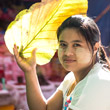Yandabo
Located approximately half way between Mandalay and Bagan on the western bank of the Irrawaddy River, Yandabo is a charming village that has the potential to add immediate cultural spice to even the most straightforward of itinerary routings. For centuries, the village has been known for its production of pottery, all of which is made from clay dug directly from the nearby riverbanks. Just a quick wander through the village will provide a first hand glimpse of the production process, ranging from the shaping of the pots to the fascinating decoration technique. History buffs may be interested to know that the Treaty of Yandabo was signed here, the peace treaty that ended the First Anglo Burmese War.
Kyiangtong (Kengtung)
Once the capital of the infamous Golden Triangle, Kyaingtong can be found in the far eastern reaches of Shan State, close to the borders of China, Laos and Thailand. Now considered one of most remote destinations accessible to tourists, the town exists today as a cultural melting pot, home to various tribes such as the Wa, Shan, Akha and Lahu. Although pleasant, the town itself has relatively little to offer tourists, with the main attractions being the morning market, One Tree Hill (a ginormous 250-year old tree) and several picturesque lakes. In order to truly appreciate what the region has to offer, a short journey into one of the surrounding villages is a must. Here you will find an abundance of culture and breathtaking trekking routes, most of which lead through beautifully terraced landscape and deep into the heart of the region’s tribal wilds. One of the most popular and least demanding routes terminates in Loimwe, the former location of the headquarters of the British District Commissioner in colonial Burma. Whilst only a fraction of this once powerful administrative centre remain, a visit here will be certain to provoke a strong sense of nostalgia.
Putao
Arguably the most remote and inaccessible destination in Myanmar, a journey to the northernmost town of Kachin State is not for the fainthearted. Famous for its endemic bird species and rare orchid varieties, Putao is a small town surrounded by snow-capped mountains, freshwater streams and luscious forest. Hkakabo Razi, the highest mountain in South East Asia, is also visible from here. Using Putao as a base, one can carry out a range of adventurous excursions including trekking, mountaineering and white water rafting. It is also possible to venture deep into the Himalayan foothills, but these expeditions are reserved for only the most experienced of mountaineers. The limited number of Putao bound flights mean that it is necessary to coordinate your plans around the dates available – that said, travel is still not guaranteed as airlines will only operate if there are sufficient passenger numbers to justify flying. Those that make it here however, will be rewarded with one of the most unforgettable travel experiences Myanmar has to offer.
Mrauk U
Nestled in northern Rakhine State’s rugged terrain, for centuries, Mrauk U was regarded as one of the most powerful and important kingdoms in Myanmar. From the 15th to 18th centuries it served as a lucrative trading hub, long frequented by the Portugese, French and Dutch, but the prosperity gained from this quickly diminished after the conquest of the kingdom by the Burmese Konbaung Dynasty in 1784. This, combined with the decision by the British to move the regional trading centre to Sittwe, help to explain Mrauk U’s now isolated state. Due to its ghost-like, temple-strewn landscape, it is easy to understand why visitors are quick to make comparisons with Bagan. There are however many differences, especially when it comes to the typical temple design. Many are barricaded with thick, bunker like stonewalls that help to protect against the sometimes fierce Rakhine winds. You are also a lot more likely to bump into a farm animal than you are another tourist, making it a must for anyone looking to veer away from the typical tourist trail. Before travelling to Mrauk U, Tour Mandalay would recommend that you first check to make sure there are no travel restrictions in place – this information can be obtained from the Burmese Embassy in your home country.
Pyay (Prome)
Pyay, or Prome as it was called during the colonial times, is a small stuppa-studded riverside town, located approximately 285km northwest of Yangon. Just east of Pyay can be found the ancient Pyu capital of Sri Ksetra, a kingdom that flourished between the 7th and 9th centuries. This site, along with two others (Halin and Beikthano), was recently inscribed into UNESCO’s World Heritage List. Whilst there is an on-going debate into their exact age, some of the stupas on display here are said to date back as far as the 4th century, with one of the most impressive being the cylindrical, brick-built Baw Baw Gyi Pagoda. Remains also include excavated palace citadels, burial grounds and early industrial production sites, as well as monumental brick Buddhist stupas, partly standing walls and water management features.

